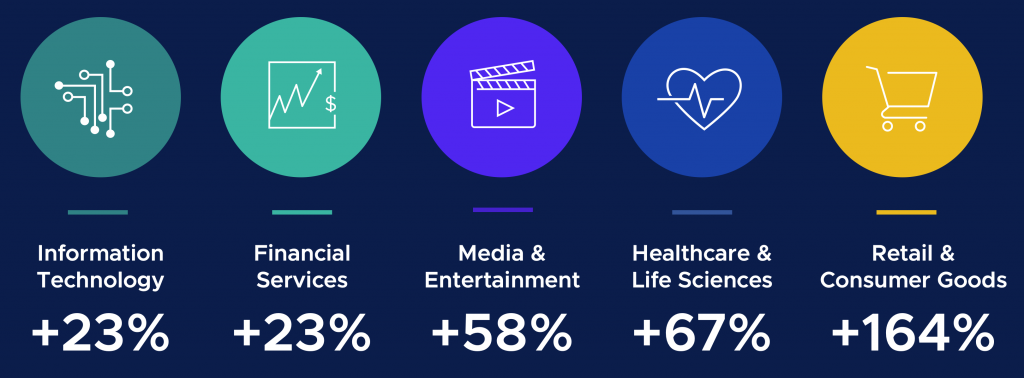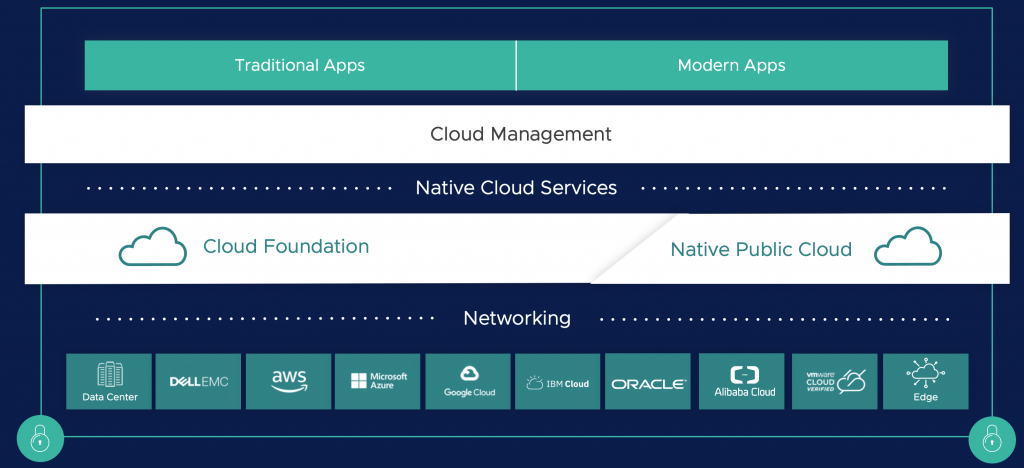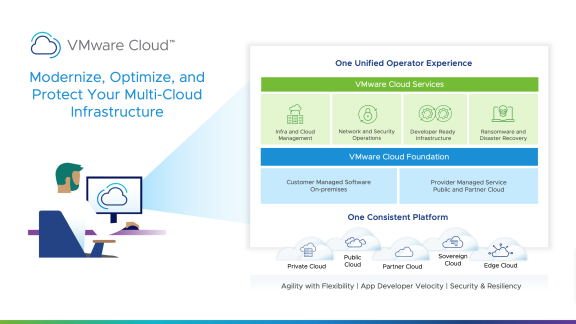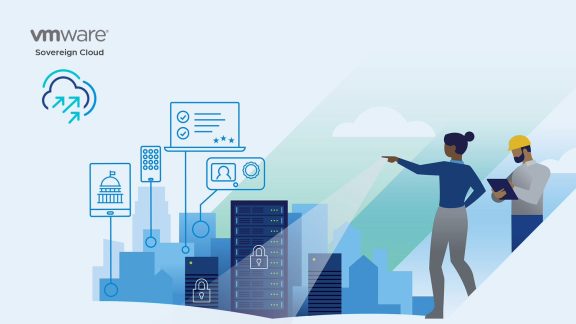The realities of the past year fundamentally changed the way organizations invest in the cloud. With a renewed focus on resilience and efficiency, as well as accelerating digital transformation efforts and innovation, organizations are rapidly adopting cloud services and multi-cloud strategies to quickly meet new business and market demands.
Understanding how to adapt to this faster-paced, cloud-centric world was a key theme of this year’s CloudLIVE conference, the industry-leading multi-cloud management conference dedicated to transforming and scaling businesses in the cloud.
Held last week, hundreds of attendees from around the world tuned in over the course of two days to learn, share, and connect with their peers across the cloud community. The event featured three cloud management tracks (cloud financial management, operations, and security and compliance), more than 16 training courses, and 30 breakout sessions, as well as a keynote address from Shark Tank’s Barbara Corcoran—all focused on helping organizations be more resilient, efficient, and innovative under any circumstances.
With all the sessions and content the event had to offer, we wanted to cover some of the major themes, key takeaways, and product announcements you may have missed. Let’s get started!
Executive insights and industry trends
In our general session, we had the opportunity to hear from Apolak Borthakur, CloudHealth’s Vice President and Product Leader, as he shed light on the current state of multi-cloud management.
Based on our analysis of actual cloud spend among our direct customers worldwide, total cloud spend increased across the board by more than 23% between January 2020 and January 2021. In some industries, such as retail and consumer goods, cloud spend increased by 164%!
See more industry insights and cloud spend data in our report: How 2020 Changed the Way We Use the Cloud
It’s evident that companies of all kinds are turning to the cloud as a key driver and enabler of their business transformation goals, especially in light of the social and economic implications of the past year. While it’s true that the cloud provides organizations with the agility, flexibility, and scalability they require, there are also a number of new challenges that come with a cloud-centric world.
Cloud customers face a lack of visibility between clouds, diverse management and operations, and inconsistent security policies—all combining to bring a level of complexity and risk that challenges the inherent benefits of the cloud.
CloudHealth by VMware, which is part of the holistic VMware Cloud portfolio of solutions, is uniquely positioned to support business’ ability to account for these challenges—to simplify cloud financial management, streamline operations, and strengthen security to get back to the reasons for adopting cloud in the first place.
“This distributed multi-cloud model delivers the flexibility to build and run any application in the best environment, with access to the vast array of innovation from cloud providers, along with a unified model for security and operations at the level every enterprise demands.
This is the vision behind VMware Cloud.” — Raghu Raghuram, Chief Operating Officer, Products And Cloud Services at VMware
To continue our support of this vision, the CloudHealth team has delivered more than 160 product enhancements since we hosted CloudLIVE last year! Here are a few of the most notable updates…
Featured CloudHealth product updates
The Flex Family of Features
As enterprises grow and scale in the public cloud, they need a better way to align their cloud management solutions to how their business is structured, especially as they grow and scale multi-cloud envrionments. Not every organization is one-size-fits all, so there needs to be a way to delegate access and permissions by lines of business, handle continuous increases in scale and complexity, and ensure the right information gets to the right people at the right time.
CloudHealth has released several updates to our Flex Family of Features to meet these needs:
- FlexOrgs: If you’re not familiar, FlexOrgs is a feature within the CloudHealth platform that provides organizations greater control over user access, sharing, and delegation across multiple levels of organizational hierarchy. With FlexOrgs, you can build, customize, and manage your organization so that individual groups are assigned unique access for managing resources, but can still work together for shared business outcomes.
- FlexReports: Taking the complexity out of data, FlexReports enable customers to easily analyze data from their cloud bill on-demand and across any variable, including accounts, cloud services, charge types, and more.For improved speed and ease-of-use, we’ve recently launched Default Templates, a new FlexReports feature that provides customers with out-of-the-box reports, including measures, dimensions, and filters that are pre-selected to address specific use cases.In addition, you can now make modifications or write more complex queries in FlexReports using the Report Query Editor (currently available in public beta). With this release, you can edit the query and preview the results of the modified/enhanced query immediately, emulating the capability of an API client.
Containers and Kubernetes management capabilities
Since we first launched container support several years ago, we’ve seen container adoption grow at a massive scale, and we’ve learned a lot about the evolving challenges in the space.
One of the primary challenges associated with running a containerized environment, whether it’s in the data center or in the public cloud, is maintaining visibility and governance around its business impact and costs. Without complete cost and usage visibility, it’s nearly impossible for organizations to accurately allocate costs for chargeback or showback reporting, or identify usage and cost spikes in a multi-cloud environment.
To that end, we’ve brought together key cost and usage reports in the CloudHealth platform to a central location—the Kubernetes Overview Report—so you can quickly and easily understand trends in aggregate, per cluster, or by namespace across all cloud environments.
You can learn more about CloudHealth’s containers and Kubernetes management capabilities in our article here.
Featured resource: FinOps for Kubernetes: Unpacking Container Cost Allocation and Optimization
Custom Cost Line Items
Our mission is to provide streamlined, simplified, and comprehensive cloud financial management, operations, and security solutions for our customers—regardless of the combination of cloud providers or services they choose.
With this in mind, we recognize how important it is for customers to have the flexibility to include or remove costs in the platform for better chargeback and showback. This is why we’re excited to introduce Custom Cost Line Items! With Custom Cost Line Items, users can add freeform text names, and specify by cloud provider or account, choose credit or charge, set the frequency of the charge, and customize the percentage of the line item that should be distributed.
Custom Cost Line Items is currently in private beta, but we’re looking forward to rolling it out to our entire customer base soon.
New multi-cloud support across the portfolio with GCP and Oracle
To continue to support our customer’s multi-cloud journeys, we’re proud to provide CloudHealth Secure State support for Google Cloud Platform (GCP), as well as CloudHealth support for Oracle Cloud Infrastructure (OCI).
To learn more about CloudHealth support for OCI, see our article here. And for more information on how to improve your Google Cloud security posture with CloudHealth Secure State, see our article here.
Solution brief: Simplify Your Google Cloud Platform with Complete Transparency
CloudHealth Secure State
Over the last year, the CloudHealth Secure State team delivered several key capabilities critical for operationalizing and improving cloud security. These include role-based access controls (RBAC) and project-specific security views for teams, 400+ new security and compliance rules to expand service and risk coverage across AWS, Azure, and Google clouds, custom compliance frameworks for building company-specific standards, and 40 remediation jobs to fix commonly occurring security violations.
As we continue to double down on helping organizations improve their cloud security risk management, we’ve continued to add new enhancements that reduce friction between security stakeholders and improve decision making through an easier exchange of insights across company tools and processes. You can see all the latest updates in our article here, which also includes our framework for operationalizing cloud security posture management.
Featured resource: 7 Best Practices for Cloud Security Posture Management
Next steps
If you’ve already registered for CloudLIVE 2021, you can still access all the content from the event on-demand by following this link (available for a limited time!).
And in case you missed it, please feel free to explore our resource library, which includes a host of blog articles, how-to guides, customer stories, webinar replays, and analyst reports—all designed to help you succeed in a fast-paced, multi-cloud world.
You can also reach out to our team directly, where we’ll be happy to discuss how CloudHealth by VMware can help your organization scale cloud usage efficiently and securely, as well as answer any questions you may have.








